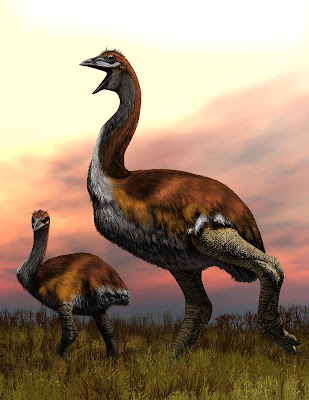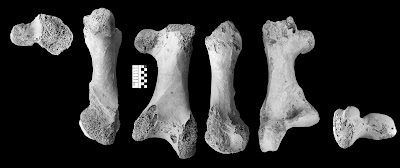|
|
| Пишет Species New to Science ( @ 2018-09-27 14:39:00 |
|
|
|
|
|
|
|
|
|
|
|
|
|
|
[PaleoOrnithology • 2018] Vorombe gen. nov. • Unexpected Diversity within the Extinct Elephant Birds (Aves: Aepyornithidae) and A New Identity for the World's Largest Bird
 |
| Vorombe titan (Andrews, 1894) |
Abstract
Madagascar's now-extinct radiation of large-bodied ratites, the elephant birds (Aepyornithidae), has been subject to little modern research compared to the island's mammalian megafauna and other Late Quaternary giant birds. The family's convoluted and conflicting taxonomic history has hindered accurate interpretation of morphological diversity and has restricted modern research into their evolutionary history, biogeography and ecology. We present a new quantitative analysis of patterns of morphological diversity of aepyornithid skeletal elements, including material from all major global collections of aepyornithid skeletal remains, and constituting the first taxonomic reassessment of the family for over 50 years. Linear morphometric data collected from appendicular limb elements, and including nearly all type specimens, were examined using multivariate cluster analysis and the Bayesian information criterion, and with estimation of missing data using multiple imputation and expectation maximization algorithms. These analyses recover three distinct skeletal morphotypes within the Aepyornithidae. Two of these morphotypes are associated with the type specimens of the existing genera Mullerornis and Aepyornis, and represent small-bodied and medium-bodied aepyornithids, respectively. Aepyornis contains two distinct morphometric subgroups, which are identified as the largely allopatric species A. hildebrandti and A. maximus. The third morphotype, which has not previously been recognized as a distinct genus, is described as the novel taxon Vorombe titan. Vorombe represents the largest-bodied aepyornithid and is the world's largest bird, with a mean body mass of almost 650 kg. This new taxonomic framework for the Aepyornithidae provides an important new baseline for future studies of avian evolution and the Quaternary ecology of Madagascar.
Systematic Palaeontology
Order Struthioniformes Latham, 1790
Family Aepyornithidae Bonaparte, 1853
Genus Aepyornis Geoffroy Saint-Hilaire, 1851
Aepiornis Geoffroy Saint-Hilaire, 1851, p. 52
Epiornis Muller and Baldamus, 1851, p. 48
Epyornis Bonaparte, 1853, p. 139
Type species: Aepyornis maximus Geoffroy Saint-Hilaire, 1851 (by monotypy).
Recognized species: Aepyornis maximus Geoffroy Saint-Hilaire, 1851; Aepyornis hildebrandti Burckhardt, 1893
.....
Genus Mullerornis Milne-Edwards and Grandidier, 1894
Flacourtia Andrews, 1895, p 23
Type species: Mullerornis betsilei Milne-Edwards and Grandidier, 1894; designated by Richmond.
Recognized species: Mullerornis modestus (Milne-Edwards and Grandidier, 1869)
 |
| Vorombe titan (Andrews, 1894) Illustration: Jaime Chirinos |
Genus Vorombe gen. nov.
Etymology: From the Malagasy for ‘big bird’ (neuter).
Type species: Aepyornis titan Andrews, 1894
Vorombe titan (Andrews, 1894)
Aepyornis titan Andrews 1894, p. 18
Aepyornis ingens Milne-Edwards and Grandidier, 1894, p. 124
 |
| Figure 7. Vorombe titan , femur (NHMUK A439), Itampolo (Itampulu Vé), Madagascar; part of syntype series. |
James P. Hansford and Samuel T. Turvey. 2018. Unexpected Diversity within the Extinct Elephant Birds (Aves: Aepyornithidae) and A New Identity for the World's Largest Bird. Royal Society Open Science. DOI: 10.1098/rsos.181295
After decades of conflicting evidence, scientists at @ZSLScience have put the ‘world’s largest bird’ debate to rest. The extinct Vorombe titan has taken the title at over 3 metres tall and weighing up to 800kg: zsl.org/science/news/zsl-names-world’s-l
Team names world's largest ever bird—Vorombe titan phys.org/news/2018-09-team-world-largest-b




